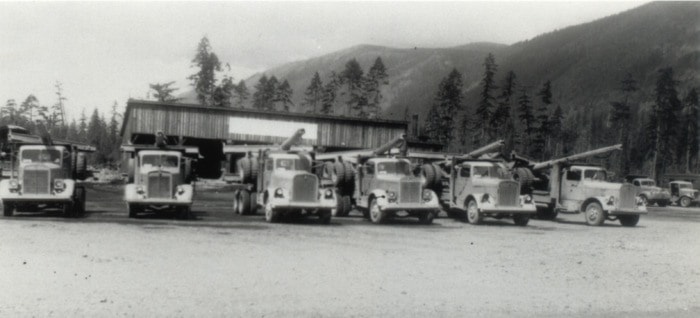Next time you make a trip to the CVRD Meade Creek Refuse and Recyclable depot try to imagine a logging camp complete with logging trucks, machinery and company owned residential homes lining the same stretch of Meade Creek Road. That’s how it was from 1942 until it closed in 1965 when the Western Forest Industries Ltd. (WFI) owned logging camp reigned supreme on the site that is now an industrial area and the location of the refuse depot and several small mills, including the Neuffer owned Karlite Manufacturing Ltd.
In the years before 1965, closing down a logging camp was a simple act with little heed paid to replanting the forest that had been removed. The logged areas were left to nature.
“Abandoned working areas were marked by a haphazard accumulation of bark, chunks and odd bits of wire rope, pieces of sawn lumber and hewn timbers.” (Cowichan Leader, 1965).
Over the years, the weather bleached yarding and landing sites began to take on the green hue of willows and other new deciduous trees which rose amid the devastation. The edges of nearby creeks and unused bridges were left to crumble and rot. “The crude (logging) camp buildings lapsed into decay and only pieces of steel were saved .”
Things slowly began to change and by 1965, a worked-out (logging) claim was replanted in large acreages, in effect tree farms. Instead of the extensive system of logging roads everywhere, the abandoned roads were deactivated leaving only an access. This “skeletal road system” was maintained should a forest fire break out near the acres of new planting.
As was the case with the closing of the WFI Meade Creek camp, nearly everything was taken away including sturdy buildings “which housed men, clerks, mechanics first-aid attendants, supervisors and other personnel.” The new and modern way was to also clear away the debris and residue from the camps and the abandoned logging sites. Even the three residential houses (used for top personnel) were removed then privately sold becoming private homes within the community of Lake Cowichan.
With the end of the once vibrant Meade Creek camp, for many, came the feeling of a final goodbye to a dear friend. Gone was the bunkhouse that had been home to many loggers, “especially the sturdy strangers from Europe” who had left their homeland to make a life in a new land. The tide had changed. Instead of company owned bunkhouses and residences, the employees rode the crummy (bus) to work each day.
Meade Creek Camp passed into history and with it, the memory of “hundreds of millions of feet of scaled logs it turned out and taken as lumber to the four corners of the globe”. Those who lived and worked there left and another chapter of life began.
Today there lays not a shred of evidence that a logging camp and all its activity once existed on the very land where we dispose of our refuse and recyclables and where finished lumber products are now milled and sold.
